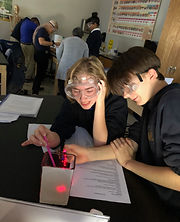
Theme: Light and Its Interaction with Matter
Light is everywhere around us, and humans wouldn't be able to survive without it.
HUMANIZING SCIENCE 2019 - 2020
HHA SCIENCE CLUB EXPERIMENTS AND PHOTOS
Reflection, Refraction, Transmission, Scattering (Part 1)
Any of these activities can be tried alone.
At a large event, participants can group into six teams that rotate through all five experiments at different stations. (One activity is a competition between two teams.)

KHET (REFLECTION)
(Two teams)
Use reflection to play a game.
Objective:
- How can you control the direction of light from its source to illuminate an object?
Download Instructions

LIGHT UP BAG AND WIGGLING SPOTS (REFLECTION)
Use lasers and plastic bags filled with water and air to experiment with reflection.
Objectives:
- How can you use reflection to light up the whole bag?
- How can you reflect light from the interface of different materials and make light spots? - How can you determine which interfaces the spots are coming from?
Download Instructions

.jpg)
INTERNAL REFLECTION
Shine the laser through the hole when water is flowing out.
Objective:
- Can you see the light “bending” with the water?
Download Instructions


BENDING LIGHT AT AN AIR/WATER INTERFACE (REFRACTION AND SCATTERING)
- Use the straw and watch how it bends when it enters the water
- Use red laser and measure angle of refraction with protractor and calculate refractive index.
Objectives
- In which direction does the straw bend?
- In which direction does the red laser light refract?
- Does the angle of refraction differ depending on the angle in which the straw and the light enter the water?
- Do you notice a difference in how the light refracts depending on which side (air or water) you view it from?
- Can you use Snell’s Law?
Download Instructions



CREATING AN INVERTING LENS FROM WATER (REFRACTION)
Observe the inversion of objects through water in a cylindrical jar
Objectives:
- What happens to the direction of an arrow when it is observed through air and when it is observed through water in a jar?
- Can you draw light rays to show why the water inverts an image?
Download Instructions
Photo Gallery

Absorption, Fluorescence, Phosphorescence, Diffraction and Prisms
(Part 2)
Download Instructions
LIGHT AS A RULER TO MEASURE OBJECTS TOO SMALL TO SEE (DIFFRACTION)
- Shine a laser through the diffraction card.
- Measure different variables in the given equation to calculate the spacing between lines on the card that are otherwise too small to see by eye
- Determine how diffraction patterns change with different laser colors.
Objectives:
- Use the diffraction cards with different-colored lasers to see the difference between laser wavelengths and line spacings on the card.


THE COLORS OF WHITE LIGHT (REFRACTION AND PRISMS)
- Shine a flashlight through a slit in black paper into a prism
- Rotate the prism to create a rainbow
Objectives
- Use Snell’s Law to calculate the refraction that makes a rainbow

.jpg)
Download Instructions
ABSORBANCE
- Compare the absorbed wavelengths of colors to the color transmitted
- Combine different color filters to make new colors and to block out light
Objectives
- Understand how the wavelengths absorbed in an object affect the wavelengths transmitted and reflected

Download Instructions
FLUORESCENCE
- Light up an object with black light. If it glows under the light and immediately stops when the flashlight is off, it is fluorescent.
- Light up an object with black light. If it is still glowing when the flashlight is off, it is phosphorescent.
Objectives
- Visualize the difference between phosphorescence and fluorescence
- Find what colors of excited light produce fluorescence

.jpg)
Download Instructions
LIGHTING UP PHOSPHORESCENT FILM
- Light up an object with white light. If it is still glowing when the flashlight is off, it is phosphorescent.
- Experiment with shining a flashlight on phosphorescent film
Objectives
- Determine how distance, illumination time, and color films affect phosphorescence


Download Instructions